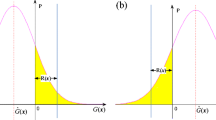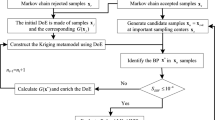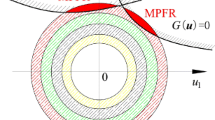Abstract
This paper investigates the improvement of system reliability analysis (SRA) methods which combine active learning Kriging (ALK) model with Monte Carlo simulation. In this kind of methods, a number of Monte Carlo samples are treated as the candidate points of the ALK models, and the size (or the number) of candidate points vitally affects the efficiency. However, the existing strategies fail to build the Kriging model with the optimal size of candidate points. Therefore, a certain quantity of training points was wasted. To circumvent this drawback, a strategy with an adaptive size of candidate points (ASCP) is exploited and seamlessly integrated into one of the recently proposed ALK model-based SRA method. In this strategy, the optimal size is iteratively predicted and updated according to the predicted information of component Kriging models. After several iterations, the optimal size can be approximately obtained, and the learning process can be executed with an optimal size of candidate points hereafter. Three numerical examples are investigated to demonstrate the efficiency and accuracy of the proposed method.





Similar content being viewed by others
Abbreviations
- ALK:
-
active learning Kriging,
- ASCP:
-
adaptive size of candidate points,
- SRA:
-
system reliability analysis,
- CRA:
-
component reliability analysis,
- FORM:
-
First order reliability method,
- SORM:
-
second order reliability method,
- MCS:
-
Monte Carlo simulation,
- Cov :
-
coefficient of variation,
- ALK-TCR:
-
ALK model with truncated candidate region,
- CPF:
-
component performance function,
- DoE:
-
design of experiments,
- TCR:
-
Truncated candidate region.
References
Bichon BJ, Eldred MS, Swiler LP, Mahadevan S, McFarland JM (2008) Efficient global reliability analysis for nonlinear implicit performance functions. AIAA J 46:2459–2468
Bichon BJ, McFarland JM, Mahadevan S (2011) Efficient surrogate models for reliability analysis of systems with multiple failure modes. Reliab Eng Syst Saf 96:1386–1395
Bourinet J-M, Deheeger F, Lemaire M (2011) Assessing small failure probabilities by combined subset simulation and support vector machines. Struct Saf 33:343–353
Cadini F, Santos F, Zio E (2014) An improved adaptive kriging-based importance technique for sampling multiple failure regions of low probability. Reliab Eng Syst Saf 131:109–117
Castillo E, Sarabia JM, Solares C, Gómez P (1999) Uncertainty analyses in fault trees and Bayesian networks using FORM/SORM methods. Reliab Eng Syst Saf 65:29–40
Ditlevsen O (1979) Narrow reliability bounds for structural systems. J Struct Mech 7:453–472
Du X (2010) System reliability analysis with saddlepoint approximation. Struct Multidiscip Optim 42:193–208
Dubourg V, Sudret B, Bourinet J-M (2011) Reliability-based design optimization using kriging surrogates and subset simulation. Struct Multidiscip Optim 44:673–690
Dubourg V, Sudret B, Deheeger F (2013) Metamodel-based importance sampling for structural reliability analysis. Probabilist Eng Mech 33:47–57
Echard B, Gayton N, Lemaire M (2011) AK-MCS: an active learning reliability method combining kriging and Monte Carlo simulation. Struct Saf 33:145–154
Fauriat W, Gayton N (2014) AK-SYS: an adaptation of the AK-MCS method for system reliability. Reliab Eng Syst Saf 123:137–144
Gaspar B, Teixeira A, Soares CG (2017) Adaptive surrogate model with active refinement combining kriging and a trust region method. Reliab Eng Syst Saf 165:277–291
Grooteman F (2008) Adaptive radial-based importance sampling method for structural reliability. Struct Saf 30:533–542
Helton JC, Johnson J, Oberkampf W, Storlie CB (2007) A sampling-based computational strategy for the representation of epistemic uncertainty in model predictions with evidence theory. Comput Methods Appl Mech Eng 196:3980–3998
Hohenbichler M, Rackwitz R (1983) First-order concepts in system reliability. Struct Saf 1:177–188
Hsu W-C, Ching J (2010) Evaluating small failure probabilities of multiple limit states by parallel subset simulation. Probabilist Eng Mech 25:291–304
Hu Z, Mahadevan S (2016a) Global sensitivity analysis-enhanced surrogate (GSAS) modeling for reliability analysis. Struct Multidiscip Optim 53:501–521
Hu Z, Mahadevan S (2016b) Resilience assessment based on time-dependent system reliability analysis. J Mech Des 138:111404
Hu Z, Nannapaneni S, Mahadevan S (2017) Efficient kriging surrogate modeling approach for system reliability analysis. AI EDAM 31:143–160
Kang W-H, Song J, Gardoni P (2008) Matrix-based system reliability method and applications to bridge networks. Reliab Eng Syst Saf 93:1584–1593
Lelièvre N, Beaurepaire P, Mattrand C, Gayton N (2018) AK-MCSi: a kriging-based method to deal with small failure probabilities and time-consuming models. Struct Saf 73:1–11
Li H-S, Ma Y-Z, Cao Z (2015) A generalized subset simulation approach for estimating small failure probabilities of multiple stochastic responses. Comput Struct 153:239–251
Mahadevan S, Raghothamachar P (2000) Adaptive simulation for system reliability analysis of large structures. Comput Struct 77:725–734
Papadopoulos V, Giovanis DG, Lagaros ND, Papadrakakis M (2012) Accelerated subset simulation with neural networks for reliability analysis. Comput Methods Appl Mech Eng 223:70–80
Perrin G (2016) Active learning surrogate models for the conception of systems with multiple failure modes. Reliab Eng Syst Saf 149:130–136
Ramachandran K (2004) System reliability bounds: a new look with improvements. Civ Eng Environ Syst 21:265–278
Sadoughi M, Li M, Hu C (2018) Multivariate system reliability analysis considering highly nonlinear and dependent safety events. Reliab Eng Syst Saf 180:189–200
Sudret B (2008) Global sensitivity analysis using polynomial chaos expansions. Reliab Eng Syst Saf 93:964–979
Sun Z, Wang J, Li R, Tong C (2017) LIF: a new kriging based learning function and its application to structural reliability analysis. Reliab Eng Syst Saf 157:152–165
Wang Z, Wang P (2015) An integrated performance measure approach for system reliability analysis. J Mech Des 137:021406
Wang Z, Wang P (2016) Accelerated failure identification sampling for probability analysis of rare events. Struct Multidiscip Optim 54:137–149
Wang P, Hu C, Youn BD (2011) A generalized complementary intersection method (GCIM) for system reliability analysis. J Mech Des 133:071003
Wang Y, Hong D, Ma X, Zhang H (2018) A radial-based centralized kriging method for system reliability assessment. J Mech Des, 140: 071403–071403–071411
Wei P, Liu F, Tang C (2018) Reliability and reliability-based importance analysis of structural systems using multiple response Gaussian process model. Reliab Eng Syst Saf 175:183–195
Wen Z, Pei H, Liu H, Yue Z (2016) A sequential kriging reliability analysis method with characteristics of adaptive sampling regions and parallelizability. Reliab Eng Syst Saf 153:170–179
Yang X, Liu Y, Gao Y, Zhang Y, Gao Z (2015) An active learning kriging model for hybrid reliability analysis with both random and interval variables. Struct Multidiscip Optim 51:1003–1016
Yang X, Liu Y, Gao Y (2016) Unified reliability analysis by active learning kriging model combining with random-set based Monte Carlo simulation method. Int J Numer Methods Eng 108:1343–1361
Yang X, Liu Y, Mi C, Wang X (2018a) Active learning kriging model combining with kernel-density-estimation-based importance sampling method for the estimation of low failure probability. J Mech Des, 140: 051402–051402–051409
Yang X, Liu Y, Fang X, Mi C (2018b) Estimation of low failure probability based on active learning kriging model with a concentric ring approaching strategy. Struct Multidiscip Optim 58:1175–1186
Yang X, Liu Y, Mi C, Tang C (2018c) System reliability analysis through active learning kriging model with truncated candidate region. Reliab Eng Syst Saf 169:235–241
Youn BD, Wang P (2009) Complementary intersection method for system reliability analysis. J Mech Des 131:041004
Youn B, Choi K, Yang R, Gu L (2004) Reliability-based design optimization for crashworthiness of vehicle side impact. Struct Multidiscip Optim 26:272–283
Yun W, Lu Z, Zhou Y, Jiang X (2018) AK-SYSi: an improved adaptive kriging model for system reliability analysis with multiple failure modes by a refined U learning function. Struct Multidiscip Optim 59:263–278
Zhang J, Xiao M, Gao L, Fu J (2018) A novel projection outline based active learning method and its combination with kriging metamodel for hybrid reliability analysis with random and interval variables. Comput Methods Appl Mech Eng 341:32–52
Funding
This work is supported by the National Natural Science Foundation of China (Grant No. 51705433, 51475386), the Fundamental Research Funds for the Central Universities (Grant No. 2682017CX028), the Open Project Program of The State Key Laboratory of Heavy Duty AC Drive Electric Locomotive Systems Integration (Grant No. 2017ZJKF04, 2017ZJKF02), and the scholarship of China Scholarship Council.
Author information
Authors and Affiliations
Corresponding author
Additional information
Responsible Editor: Nestor V Queipo
Publisher’s note
Springer Nature remains neutral with regard to jurisdictional claims in published maps and institutional affiliations.
Rights and permissions
About this article
Cite this article
Yang, X., Mi, C., Deng, D. et al. A system reliability analysis method combining active learning Kriging model with adaptive size of candidate points. Struct Multidisc Optim 60, 137–150 (2019). https://doi.org/10.1007/s00158-019-02205-x
Received:
Revised:
Accepted:
Published:
Issue Date:
DOI: https://doi.org/10.1007/s00158-019-02205-x




